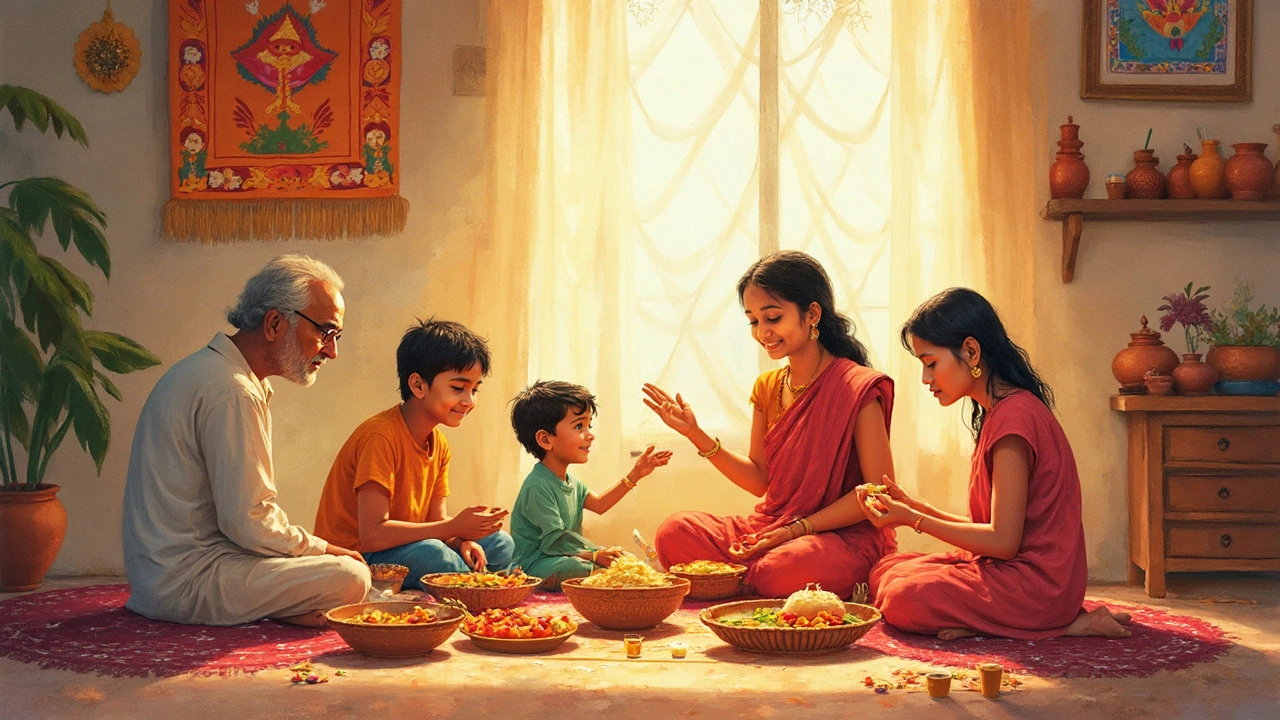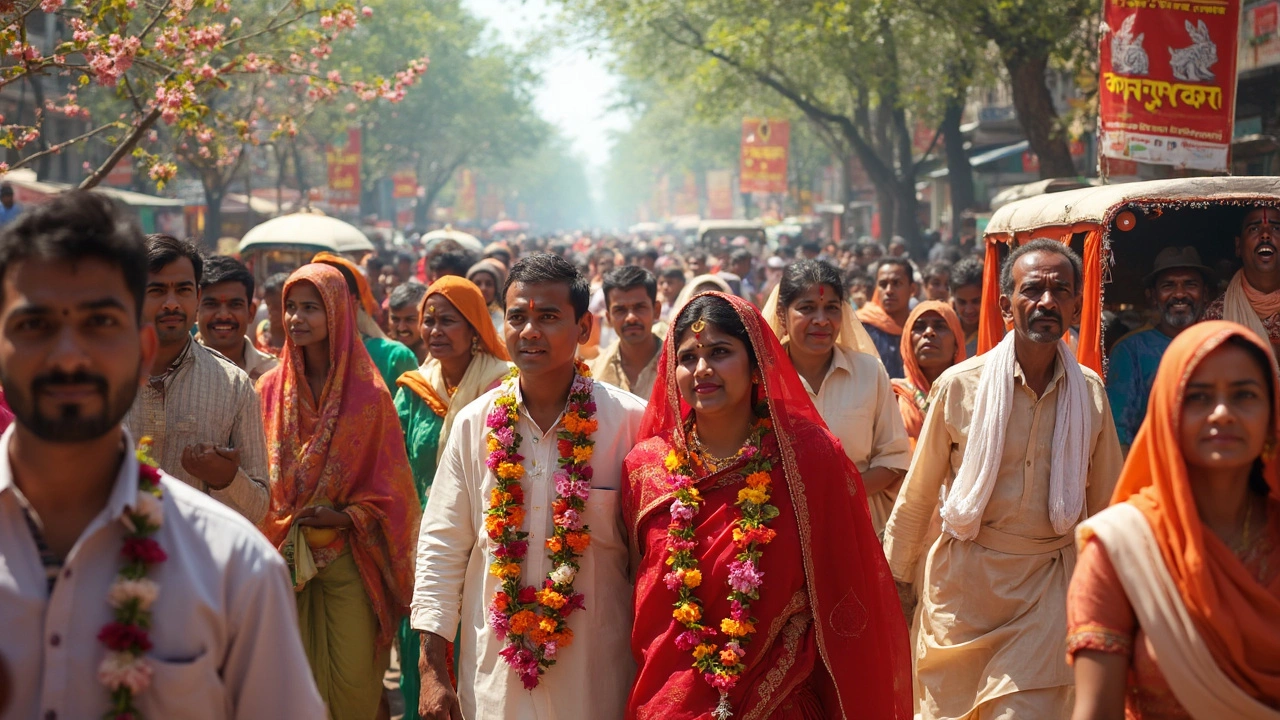Most people think of national festivals as serious, flag-waving events. Not in Bangladesh. Here, the biggest festival hits like a dose of joy: Pohela Boishakh. It’s the Bengali New Year, but honestly, it feels more like the whole country pressing reset and celebrating everything good about being alive.
What’s wild is how it takes over every street and neighborhood. You see kids in bright colors, even grumpy neighbors waving and laughing, and food stalls popping up everywhere. Shops decorate with banners that say 'Shubho Noboborsho' (that’s "Happy New Year" in Bengali). It’s like the city agrees to press pause on normal worries—no one cares what you do for a living, just that you’re out and soaking up the vibe.
If you want to dive into Bengali culture, there’s no better time. You can show up anywhere—in the capital, Dhaka, or a tiny village—and get pulled in. Someone will hand you a plate of panta bhat (soaked rice) with hilsa fish, and trust me, nobody lets you go hungry at Pohela Boishakh.
- Pohela Boishakh: The True National Festival
- How the Celebration Unfolds
- Traditions That Make It Unique
- Tips for Experiencing the Festival
Pohela Boishakh: The True National Festival
Pohela Boishakh is the one day when the whole of Bangladesh forgets daily hassles and welcomes a new start. It’s not just a holiday—it’s seen as Bangladesh’s national festival, cementing its place at the core of Bengali culture. The event marks the first day of the Bengali calendar, which falls on April 14 every year, no matter what. That’s a date to circle on your calendar if you want to see the country at its happiest.
The festival has roots going back over 600 years. Back in the Mughal period, local farmers and landlords created this new year celebration to settle accounts and start with a clean slate. Even now, businesses open new account books, known as ‘haal khata,’ on this day, inviting customers for sweets and best wishes. It’s a blend of business, community, and pure celebration.
Across towns and cities, the day begins early in the morning. Many people head to parks or riversides to join public gatherings. The biggest crowd-puller? Dhaka’s Mongol Shobhajatra. This huge parade was actually recognized as a UNESCO Intangible Cultural Heritage in 2016—yep, it’s that big of a deal. People build massive colorful masks and floats shaped like animals and birds. It isn’t just for looks; each symbol stands for peace and good luck in the new year.
| Event | Unique Element |
|---|---|
| Mongol Shobhajatra, Dhaka | Giant masks & community walking together |
| Baishakhi Mela (Countrywide Fairs) | Traditional music, folk games, local crafts |
| Food Rituals | Panta bhat & hilsa fish, laddu, sweets |
If you’re curious why this day unites Bangladeshis everywhere, it’s simple: everyone’s invited. There’s no strict dress code—though many throw on something red and white, the festival colors. No matter where you’re from, people will pull you right into the fun. For Bangladeshis living abroad, this festival is a piece of home that never fades.
How the Celebration Unfolds
The energy of Pohela Boishakh starts building even before sunrise. People get ready early, dressing up in red and white—these are the signature festival colors. There’s usually a big rush to the main spots in cities and towns. In Dhaka, for example, the celebration kicks off at Ramna Park, where crowds gather for music and the famous Mongol Shobhajatra parade.
This parade isn’t just people walking in a line. You’ll see huge, handmade masks, colorful floats shaped like animals, and drummers keeping everyone hyped. It started as a protest during hard times in the 1980s, and now it’s pure joy—recognised by UNESCO as an Intangible Cultural Heritage. That’s a big deal in local pride.
When that’s done, everyone moves on to the food. Restaurants and homes serve up classic dishes like panta bhat (fermented rice), fried fish, and spicy bhortas (mashed veggies and fish). Some families even swap home-cooked snacks with neighbors. It’s the one day when you’ll find even strict health-watchers eating their fill. If you’re out in the city, lines form outside old-school Bengali sweet shops by mid-morning.
Workplaces, schools, and universities join in too. People greet each other with 'Shubho Noboborsho,' and bosses hand out sweets. Many businesses open new account books for the year, a tradition called "Hal Khata." It’s all about a fresh start.
- The Bangladesh national festival is public—nobody needs a ticket.
- Dhaka’s Mongol Shobhajatra parade usually starts at 9 a.m. from the Faculty of Fine Arts.
- Many folks try to catch cultural performances by local artists or even big pop concerts in the evening.
Here’s a quick look at some typical Pohela Boishakh events across Bangladesh:
| City/Town | Main Attraction | Time |
|---|---|---|
| Dhaka | Mongol Shobhajatra, Ramna Park concerts | Morning |
| Chattogram | Parade through Central Stadium | Morning |
| Rajshahi | Folk music near Padma River | Afternoon |
| Sylhet | Open air poetry readings | Evening |
What ties it all together? Anyone can join, whether you’re a local or just visiting. The Bengali culture really shines during Pohela Boishakh, and you don’t even need to know the language to feel included.

Traditions That Make It Unique
There’s nothing cookie-cutter about the Bangladesh national festival. Pohela Boishakh brings out customs that feel both ancient and fresh. Early morning processions, called Mangal Shobhajatra, start off the day. Handmade masks with bright colors, giant bird figures, and even papier-mâché animals take over the streets. UNESCO actually recognized this procession as world cultural heritage—so yes, it’s a big deal.
Music is non-stop on this day. You’ll catch folk songs blasting from open-air stages, and anyone is welcome to join in. People sing Rabindra Sangeet (songs by Rabindranath Tagore) and greet each other with "Shubho Noboborsho." There’s even old-school poetry readings—nothing snooty, just stories everyone relates to.
Food? It's almost a challenge to keep up. The real stars of Pohela Boishakh are:
- Panta bhat—fermented rice
- Fried hilsa fish (the crowd favorite!)
- Green chilies and pickles for a spicy kick
- Traditional sweets like sandesh and roshogolla
Women and girls wear red-and-white saris, while men put on panjabis or kurtas. You see endless bangles and flower garlands everywhere. Kids get their faces painted, and even if you show up as a tourist, local families will invite you to join their meal.
What really sets Pohela Boishakh apart is the cross-cultural feel. Muslims, Hindus, Buddhists, and Christians all come together. There’s no religious limit—just pure celebration of Bengali culture. A simple fact: a 2023 survey showed nearly 90% of Bangladeshis say Pohela Boishakh is their favorite holiday, beating even the big religious ones. That unites the entire country like nothing else can.
And here’s a tip—if you’re after iconic photos or want real local flavor, visit Ramna Park in Dhaka. That’s where some of the oldest and loudest festivities go down. If you can, join the breakfast crowd for a plate of panta bhat with hilsa at dawn. You’ll never forget it.
Tips for Experiencing the Festival
If you want to soak up the real Bangladesh national festival feeling, you gotta plan right. Here’s what you actually need to know before heading out for Pohela Boishakh. This isn’t just another cultural event—this is the day the whole country flips to party mode.
- Dress the Part: Red and white clothes are everywhere. Folks (especially kids and women) dress up in cotton saris or punjabis with bright floral prints. If you want to blend in and snap better pictures, skip the jeans for a day and go traditional.
- Start Early: Most big events—like the epic Mongol Shobhajatra parade in Dhaka—kick off at sunrise. That means if you roll out of bed at 10AM, you’ll miss the coolest stuff. Set an early alarm, grab a sweet bread (rosomalai or mishti), then join the crowd.
- Eat Local: Traditional food matters a lot. Try panta bhat (rice soaked overnight) with fried hilsa fish, lentils, and pickles. It’s this classic once-a-year combo. Street food stalls are safe bets—just check for long lines (that means the food’s fresh and tasty).
- Expect Crowds: This isn’t just busy—it’s packed. Last year, an estimated 2 million people attended outdoor events in Dhaka alone. Stick with your group, keep valuables close, and use a map app if you’re new to the area.
- Join the Parade: Don’t just watch the Mongol Shobhajatra—walk along for a bit. The parade, recognized by UNESCO as a cultural heritage, is loud, colorful, and full of giant animal masks. It’s welcoming to everyone, tourist or local.
- Look for Cultural Programs: Music and dance shows pop up all over—parks, campuses, and even roadsides. These aren’t stiff performances; random folks join in singing Rabindra Sangeet or traditional folk songs. Jump in if you know the words!
- Stay Safe: Police and volunteer groups are everywhere, but be smart—stick to major streets, avoid dark alleys, and carry cash (ATMs run out fast). Sunscreen and bottled water save lives in the April heat.
Here's a quick glimpse at some Pohela Boishakh essentials across Bangladesh in 2024:
| City | Main Event | Estimated Attendees |
|---|---|---|
| Dhaka | Mongol Shobhajatra Parade | 2,000,000+ |
| Chattogram | Traditional Boat Racing | 300,000+ |
| Khulna | Open-air Music Concerts | 150,000+ |
The vibe is easy-going and welcoming—whether you’re shy or a party animal. If you don’t know the language, just smile and say 'Shubho Noboborsho.' You’ll fit right in, and somebody nearby will probably hand you a sweet or a selfie.
